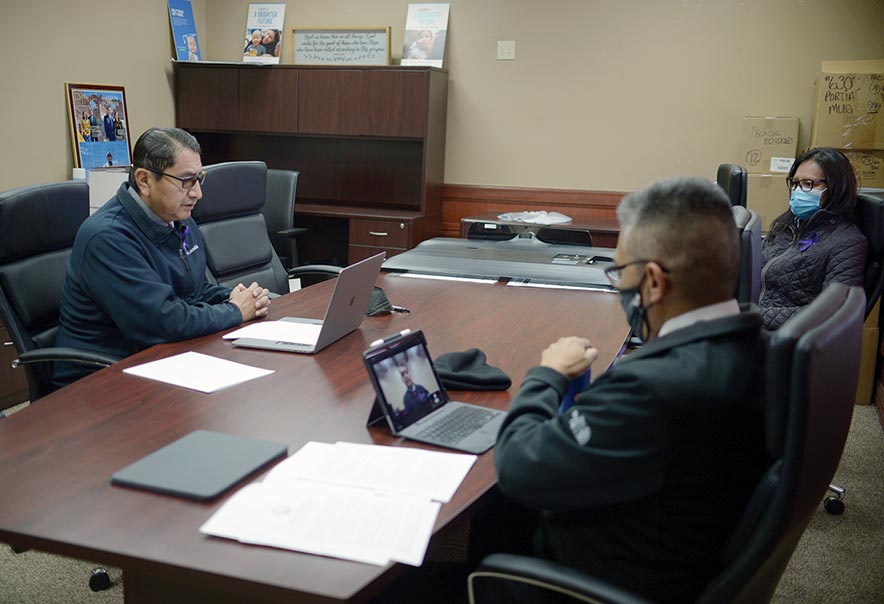
Nez, Lizer implements planning model, highlights vet funding in State of the Nation
WINDOW ROCK
President Jonathan started off the Navajo Nation Council’s fall session with his state of the nation address.
Nez spoke about budget decisions made for fiscal 2022 and said that he wants to make it clear that the comprehensive budget fully funds many services and programs that benefit veterans, elders, youth, and provides funding for prosecutors, criminal investigators, and public safety officials.
He said with the Division of Public Safety comes a lot of work and a lot of needs.
Because of this, he said the Drug and Alcohol Task Force will be reestablished and has been funded alongside the missing persons office and the Diné Action Plan (formerly known as the Tribal Action Plan).
Council Delegate Amber Kanazbah Crotty sponsored the Diné Action Plan. The plan was reestablished earlier this month and signed into law on Oct. 15.

Navajo Times | Donovan Quintero
President Jonathan Nez, left, gives his state of the nation address virtually while Vice President Myron Lizer, middle, and first lady Phefelia Nez look on in Window Rock on Monday.
Planning model
This plan applies the traditional Diné planning model of thinking (nitsaahakees), planning (nahat’á), living (‘iiná), and reflection (sihasin) to address problems on the Nation in public safety, violence, substance abuse, suicide, and missing and murdered Diné relatives.
Nez said the Diné Action Plan brings all the different divisions within public safety together to focus on Diné families.
“We are addressing the needs for healing our families and that’s the bottom line is healing our families, especially through a pandemic as we are going through right now,” he said.
Nez also gave an update on the American Rescue Plan Act or ARPA with current funds at a total of $2.1 billion.
He said he had a meeting with Council on Friday where a plan was presented to use $780 million for water, power lines, broadband, housing, and bathroom additions.
In this same plan, $350 million would be used for education, health care, social services, economic development, and tourism; $220 million would go toward chapter projects and $100 million toward enterprises.
He said that in a previous resolution, there was a plan to allocate about $207 million toward another round of hardship assistance. However, to increase the funding, the support of the Council is needed to amend their resolution which set the levels for ARPA funds.
Funding for veterans
Vice President Myron Lizer spoke about funding for veterans. He said he and Nez have met with Diné veterans lately and they will continue to advocate and utilize their powers as elected leaders of the Nation to help veterans.
He spoke about the Veterans Housing Initiative and said they are trying to find the best method to go with the initiative.
He also said they are working hard on bringing these homes to fruition whether they be hogans or traditional-styled homes.
“Whatever we go forward with here will be with the input of our veterans, the majority of them,” Lizer said.
Within the current budget, funding for Diné veterans is allocated under the Navajo Veterans Administration.
Nez said if a majority of veterans want the funds to instead be available under the chapter veterans’ organizations, then they will support that through an amendment to the comprehensive budget which will be voted on by the Council.
Nez said that he understands that many veterans have expressed concerns and frustrations with the process of receiving assistance, which includes an individual submitting receipts for the assistance they receive.
“We proposed to simply have the person provide a signature certifying that the funds were used for the intended purpose,” Nez said. “If a veteran submits a request for assistance, we should make the process as simple as possible while ensuring accountability of Navajo funds.”
Healing begins
Nez spoke about the federal Indian Boarding School Initiative to identify burial sites on former boarding schools. He said his administration supports those efforts.
He said that from this initiative, the Navajo people could begin to heal so that future generations will be empowered by all the wrongdoings our people have endured.
He also showed support for the Radiation Exposure Compensation Act or RECA. This act was first enacted in 1990 and is set to expire in 2022.
However, amendments introduced last month would extend the act until 2040, expand downwinder eligibility based on geographic location, and expand the years that can used for figuring out exposure for individuals working in a uranium mine, mill, or transporting uranium ore.
Lizer said they urged Congress to include the amendments and to increase the compensation cap to a minimum of $200,000 per individual regardless of worker classification or category of disease.
“The RECA amendments of 2021 presents an opportunity for Congress to work with the Navajo Nation, the Navajo Uranium Radiation Victims Committee, and other impacted groups to appropriately extend RECA’s coverage,” Nez said.
Paving the way
Nez also talked about the work the Navajo Division of Transportation has done within the last year. He said in August, a resolution was approved by Council to use $19.5 million to pave existing dirt roads between Hard Rock and Piñon.
Also in August, construction started of a 7-mile stretch of N71 that includes the pavement of the dirt road. Manuelito Canyon Bride was repaired and replaced, alongside a bridge located along N9402.
“We know that the improvement of roads across our Nation is always a top priority and one of the top needs in nearly every community,” Nez said.
Nez requested the support of Council to set aside $50 million from the Sihasin Fund to create more scholarship opportunities for Navajo students. He said the Nation must invest in scholarships for the growing number of students who are pursuing their educational goals.
Nez ended his address with encouraging Navajo people to keep COVID-19 and its impact in mind. He encouraged people to get fully vaccinated and continue to take precautions such as wearing masks.
“We join our Navajo people in praying for strength, wisdom, protection, and good health,” Nez said.








 Highway 264,
Highway 264, I-40, WB @ Winslow
I-40, WB @ Winslow